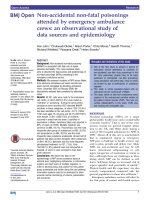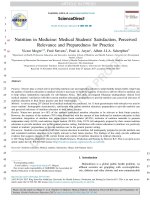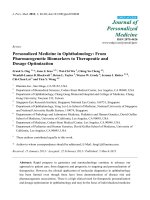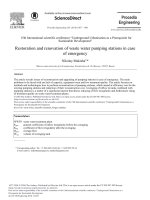Pediatric emergency medicine trisk 2443 2443
Bạn đang xem bản rút gọn của tài liệu. Xem và tải ngay bản đầy đủ của tài liệu tại đây (73.33 KB, 1 trang )
Hemodialysis is a rapid and effective method for removing ammonia. Extracorporeal membrane
oxygenation (ECMO) is the most effective method of ammonia removal but has higher risks than other
forms of dialysis, particularly in neonates. Exchange transfusion is not effective. There is no consensus
on what type of ammonia removal should be employed based on ammonia concentration. Dialysis is most
effective for ammonia concentrations higher than 300 μg/dL. Recommendations of the New England
Consortium are to perform dialysis for ammonia >300 μg/dL if concentration is rising, prepare for
possible dialysis for ammonia >200 to 250 μg/dL, engaging receiving dialysis unit/facility as soon as
possible. If dialysis is not immediately available or levels are higher than 100 to 125 μg/dL but lower
than 200 μg/dL, pharmacologic agents for ammonia removal should be administered to patients with
known or suspected urea cycle defect. Sodium phenylacetate and sodium benzoate, available in
combination as the preparation Ammonul, 100 mg each per mL (Ucyclyd Pharma, Inc., Scottsdale, AZ;
1-888-829-2593) eliminates nitrogen by an alternative pathway that does not rely on an intact urea cycle.
Ammonul does not remove ammonia rapidly enough to serve as primary therapy in patients with severe
hyperammonemia. Arginine, which enhances urea cycle activity in patients with most urea cycle defects,
should be administered in the face of hyperammonemia using arginine HCl 10% at a dose of 200 to 600
mg/kg IV over 90 to 120 minutes, followed by the same dose over 24 hours. Arginine HCl can be mixed
with Ammonul. If Ammonul/arginine HCl is being administered, the hourly infusion rate of maintenance
fluids should be reduced by the volume of Ammonul/arginine HCl being given. Given the high
concentration of sodium in Ammonul and chloride in arginine HCl, extreme caution must be taken if
administering other sodium chloride–containing fluids. Sodium phenylacetate may deplete potassium.
Potassium should be replaced as potassium acetate. Ondansetron (0.15 mg/kg up to every 8 hours) should
be administered for vomiting and/or prophylactically if treating with Ammonul. To assess patient
response to treatment, ammonia, electrolytes, and blood gas should be monitored every 4 hours. Usually,
2 to 3 days of therapy is necessary.
For seizures unresponsive to conventional anticonvulsants, empiric therapy with pyridoxine (B6 ; 100
mg IV), folic acid (leucovorin; 2.5 mg IV), and/or biotin (10 to 40 mg delivered by nasogastric tube)
should be considered in neonates and infants to treat a possible cofactor-responsive IEM. While there are
other disease-specific pharmacologic agents, their administration is rarely indicated in the ED. L carnitine may be administered in acutely life-threatening situations for suspicion of disorders associated
with carnitine deficiency, but its use is controversial and consultation with an IEM specialist is
recommended. L -carnitine is given at a dose of 25 to 50 mg/kg over 2 to 3 minutes or as an infusion
added to the maintenance fluid, followed by 25 to 50 mg/kg over 24 hours, maximum 3 g/day. Given that
some IEMs are associated with increased risk of infection and that serious bacterial infection can
precipitate metabolic crisis, antibiotics should be considered for any patient of concern for possible
serious bacterial infection. Fresh frozen plasma may be indicated for patients with coagulopathy.
KNOWN IEM
Goals of Treatment
For the child with known IEM and acute decompensation, goals of treatment are to expediently and
proactively evaluate for and manage cardiopulmonary decompensation and IEM-specific metabolic
derangements, and restore and maintain hydration. The child with an IEM in the ED for conditions that
could precipitate decompensation, such as acute infectious process, but presently without acute
manifestations of their IEM should receive aggressive therapy to prevent metabolic derangements and
decompensation. The family may have an emergency treatment plan with them developed by an IEM
specialist, specifically for their child. Use of clinical pathways for treatment of patients with an IEM in
the ED has been shown to improve timeliness and effectiveness of care. All patients with decompensation
should be admitted to the hospital, and there should be a low threshold for admitting any patient at risk
for acute decompensation.









